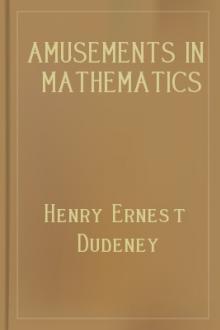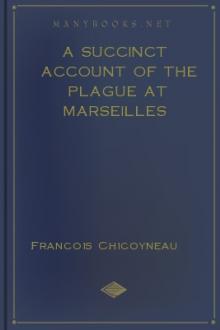Amusements in Mathematics, Henry Ernest Dudeney [books to read to be successful txt] 📗

- Author: Henry Ernest Dudeney
- Performer: 0486204731
Book online «Amusements in Mathematics, Henry Ernest Dudeney [books to read to be successful txt] 📗». Author Henry Ernest Dudeney

In Diagram 3 I show the simple solution to the second question. It is obviously correct, and may be proved by the cutting and superposition of parts. The dotted lines will also serve to make it evident. The third question is solved by the cut CD in Diagram 2, but it remains to be proved that the piece F is really one-half of the Yin or the Yan. This we will do in Diagram 4. The circle K has one-quarter the area of the circle containing Yin and Yan, because its diameter is just one-half the length. Also L in Diagram 3 is, we know, one-quarter the area. It is therefore evident that G is exactly equal to H, and therefore half G is equal to half H. So that what F loses from L it gains from K, and F must be half of Yin or Yan.
159.—THE SQUARE OF VENEER.—solution

Any square number may be expressed as the sum of two squares in an infinite number of different ways. The solution of the present puzzle forms a simple demonstration of this rule. It is a condition that we give actual dimensions.
In this puzzle I ignore the known dimensions of our square and work on the assumption that it is 13n by 13n. The value of n we can afterwards determine. Divide the square as shown (where the dotted lines indicate the original markings) into 169 squares. As 169 is the sum of the two squares 144 and 25, we will proceed to divide the veneer into two squares, measuring respectively 12x12 and 5x5; and as we know that two squares may be formed from one square by dissection in four pieces, we seek a solution in this number. The dark lines in the diagram show where the cuts are to be made. The square 5x5 is cut out whole, and the larger square is formed from the remaining three pieces, B, C, and D, which the reader can easily fit together.
Now, n is clearly 5/13 of an inch. Consequently our larger square must be 60/13 in. × 60/13 in., and our smaller square 25/13 in. × 25/13 in. The square of 60/13 added to the square of 25/13 is 25. The square is thus divided into as few as four pieces that form two squares of known dimensions, and all the sixteen nails are avoided.
Here is a general formula for finding two squares whose sum shall equal a given square, say a². In the case of the solution of our puzzle p = 3, q = 2, and a = 5.
2pqa / a²( p² + q²)² - (2pqa)²
--------- = x; --------------------------- = y
p² + q² p² + q²
Here x² + y² = a².
160.—THE TWO HORSESHOES.—solution
The puzzle was to cut the two shoes (including the hoof contained within the outlines) into four pieces, two pieces each, that would fit together and form a perfect circle. It was also stipulated that all four pieces should be different in shape. As a matter of fact, it is a puzzle based on the principle contained in that curious Chinese symbol the Monad. (See No. 158.)

The above diagrams give the correct solution to the problem. It will be noticed that 1 and 2 are cut into the required four pieces, all different in shape, that fit together and form the perfect circle shown in Diagram 3. It will further be observed that the two pieces A and B of one shoe and the two pieces C and D of the other form two exactly similar halves of the circle—the Yin and the Yan of the great Monad. It will be seen that the shape of the horseshoe is more easily determined from the circle than the dimensions of the circle from the horseshoe, though the latter presents no difficulty when you know that the curve of the long side of the shoe is part of the circumference of your circle. The difference between B and D is instructive, and the idea is useful in all such cases where it is a condition that the pieces must be different in shape. In forming D we simply add on a symmetrical piece, a curvilinear square, to the piece B. Therefore, in giving either B or D a quarter turn before placing in the new position, a precisely similar effect must be produced.
161.—THE BETSY ROSS PUZZLE.—solution
Fold the circular piece of paper in half along the dotted line shown in Fig. 1, and divide the upper half into five equal parts as indicated. Now fold the paper along the lines, and it will have the appearance shown in Fig. 2. If you want a star like Fig. 3, cut from A to B; if you wish one like Fig. 4, cut from A to C. Thus, the nearer you cut to the point at the bottom the longer will be the points of the star, and the farther off from the point that you cut the shorter will be the points of the star.

162.—THE CARDBOARD CHAIN.—solution
The reader will probably feel rewarded for any care and patience that he may bestow on cutting out the cardboard chain. We will suppose that he has a piece of cardboard measuring 8 in. by 2½ in., though the dimensions are of no importance. Yet if you want a long chain you must, of course, take a long strip of cardboard. First rule pencil lines B B and C C, half an inch from the edges, and also the short perpendicular lines half an inch apart. Rule lines on the other side in just the same way, and in order that they shall coincide it is well to prick through the card with a needle the points where the short lines end. Now take your penknife and split the card from A A down to B B, and from D D up to C C. Then cut right through the card along all the short perpendicular lines, and half through the card along the short portions of B B and C C that are not dotted. Next turn the card over and cut half through along the short lines on B B and C C at the places that are immediately beneath the dotted lines on the upper side. With a little careful separation of the parts with the penknife, the cardboard may now be divided into two interlacing ladder-like portions, as shown in Fig. 2; and if you cut away all the shaded parts you will get the chain, cut solidly out of the cardboard, without any join, as shown in the illustrations on page 40.
It is an interesting variant of the puzzle to cut out two keys on a ring—in the same manner without join.

164.—THE POTATO PUZZLE.—solution
As many as twenty-two pieces may be obtained by the six cuts. The illustration shows a pretty symmetrical solution. The rule in such cases is that every cut shall intersect every other cut and no two intersections coincide; that is to say, every line passes through every other line, but more than two lines do not cross at the same point anywhere. There are other ways of making the cuts, but this rule must always be observed if we are to get the full number of pieces.

The general formula is that with n cuts we can always produce (n(n + 1) + 1)/2 . One of the problems proposed by the late Sam Loyd was to produce the maximum number of pieces by n straight cuts through a solid cheese. Of course, again, the pieces cut off may not be moved or piled. Here we have to deal with the intersection of planes (instead of lines), and the general formula is that with n cuts we may produce ((n - 1)n(n + 1))/6 + n + 1 pieces. It is extremely difficult to "see" the direction and effects of the successive cuts for more than a few of the lowest values of n.
165.—THE SEVEN PIGS.—solution
The illustration shows the direction for placing the three fences so as to enclose every pig in a separate sty. The greatest number of spaces that can be enclosed with three straight lines in a square is seven, as shown in the last puzzle. Bearing this fact in mind, the puzzle must be solved by trial.

166.—THE LANDOWNER'S FENCES.—solution
Four fences only are necessary, as follows:—

167.—THE WIZARD'S CATS.—solution
The illustration requires no explanation. It shows clearly how the three circles may be drawn so that every cat has a separate enclosure, and cannot approach another cat without crossing a line.

168.—THE CHRISTMAS PUDDING.—solution
The illustration shows how the pudding may be cut into two parts of exactly the same size and shape. The lines must necessarily pass through the points A, B, C, D, and E. But, subject to this condition, they may be varied in an infinite number of ways. For example, at a point midway between A and the edge, the line may be completed in an unlimited number of ways (straight or crooked), provided it be exactly reflected from E to the opposite edge. And similar variations may be introduced at other places.

169.—A TANGRAM PARADOX.—solution
The diagrams will show how the figures are constructed—each with the seven Tangrams. It will be noticed that in both cases the head, hat, and arm are precisely alike, and the width at the base of the body the same. But this body contains four pieces in the first case, and in the second design only three. The first is larger than the second by exactly that narrow strip indicated by the dotted line between A and B. This strip is therefore exactly equal in area to the piece forming the foot in the other design, though when thus distributed along the side of the body the increased dimension is not easily apparent to the eye.

170.—THE CUSHION COVERS.—solution

The two pieces of brocade marked A will fit together and form one perfect square cushion top, and the two pieces marked B will form the other.
171.—THE BANNER PUZZLE.—solution
The illustration explains itself. Divide the bunting into 25 squares (because this number is the sum of two other squares—16 and 9), and then cut along the thick lines. The two pieces marked A form one square,





Comments (0)